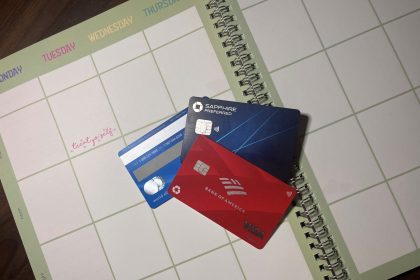Images by GettyImages; Illustration by Bankrate
Key takeaways
- Cash-out auto loan refinancing — ideally with a lower rate and without prolonging your repayment — could help you consolidate and pay off other debt or bills.
- This strategy could be useful if you’ve improved your credit since you last borrowed and have sufficient equity in your vehicle.
- However, refinancing a loan for a depreciating asset means you could increase the cost of your repayment and risk owing more than your vehicle is worth.
- Run the numbers before proceeding to see if refinancing helps you accomplish debt repayment goals without taking on too much risk.
If you’re an auto loan-holder, you might be accustomed to pre-approved refinancing offers landing in your email inbox, or even your actual mailbox. They’re often from a bank or credit union that houses your checking or savings accounts and tracks your credit score. They know you well, and they promise to refinance your auto loan to a lower rate.
Given today’s macroeconomics — rising levels of consumer debt, the potential reversal of inflation and, thanks to tariffs, whispers of a recession — you listen to their pitch. Perhaps you even wonder whether you could refinance your auto loan to pay off other debt at a decreased cost. After all, auto loan rates generally trend far lower than other consumer loan APRs.
| Product | Term (years) | Average interest rate* |
| Auto loan (new car) | 5 | 8.04% |
| Personal loan | 2 | 11.66% |
| Credit card | n/a | 21.37% |
| *From commercial banks in February 2025, according to the Federal Reserve | ||
Like with cash-out mortgage refinancing, cash-back auto loan refinancing means borrowing from the equity you’ve established in your vehicle to pay off your original auto loan plus other obligations.
“In the data that we’re seeing, an average refinance is saving a consumer about $60 a month in their monthly payment — and that can certainly help cover other bills,” says Experian head of automotive insights Melinda Zabritski. “But I think it’s also important… to take more than just the monthly payment savings into consideration.”
Does the math of cash-back auto refinancing make it worthwhile?
Let’s say you originally borrowed the average auto loan in January 2023, according to Experian figures: $40,484 to be repaid over six years with a 7.16 percent interest rate.
Let’s also assume you’ve been plodding along in repayment for 28 months (through April 2025) and have built up about $13,000 in equity.
| Original loan | Current loan | |
| Loan amount | $40,484 | $27,291 |
| Repayment term | 72 months | 44 months |
Now, you’re considering some refinance offers that would help you consolidate and clear $10,000 in credit card debt (with an average interest rate north of 21 percent).
| Current auto loan | Credit card debt | Refinancing Offer 1 | Refinancing Offer 2 | |
| Amount | $27,291 | $10,000 | $37,291 | $37,291 |
| Repayment term | 44 months | Revolving | 48 months | 72 months |
| Interest rate | 7.16% | 21% | 5% | 7% |
| Monthly payment | $693 | As much as you can | $859 | $636 |
| Total interest cost | $3,909 | Eek | $3,931 | $8,485 |
| Total repayment cost | $31,200 | Who knows? | $41,222 | $45,776 |
| Calculations via our free-to-use loan payment calculator | ||||
If you’re truly struggling to catch up on credit card debt, it might seem like a no-brainer to grab Offer 1 (for the shorter term) or Offer 2 (for the lower monthly payment). After all, you’d probably rather pay off that debt at 5 percent or 7 percent interest as opposed to 21 percent-plus.
But keep in mind that it’s not so straightforward to determine whether cash-back auto refinancing is the right strategy. You must also account for the interest costs associated with lengthening your loan term.
Right now, on average, we’re seeing refinance where a consumer has originally booked a 72-month loan. They might’ve paid the loan down for 18, 20 months, but now they’re re-booking it at a 65-month loan… So now you’ve got an effective term that’s considerably longer than the original.
— Melinda Zabritski, Experian head of automotive insights
Consider that…
- Offer 1 would lengthen your loan term by four months. But thanks to the lower interest rate and higher monthly payment ($166 higher, in fact), it would only increase your overall interest costs by $22 (as compared to your current auto loan).
- Offer 2 would add 28 months to your existing auto loan term. And the lengthier repayment would up your overall interest expense by $4,554. Still, it might be a fit if you prefer the lower monthly payment ($57 lower, in fact, than your current auto loan).
If these hypothetical offers still sound appealing, be aware — there are additional layers to unfurl.
Questions to consider before opting for cash-back refinancing
How much equity do you have in your vehicle?
Cash-out (or cash-back) auto loan refinancing is only really helpful if you own enough of your vehicle. That’s because it’s your equity that allows you to borrow more and redirect the funds to your other debt.
In the example above, we assumed our hypothetical borrower had paid off about 33 percent. The more equity you have, the better off you’ll be (in every respect).
Do you plan to keep your vehicle?
For the sake of argument, let’s say you’re intrigued by offer 2 (above). If you went this route, though, you may very likely owe more than your wheels are worth.
| Progress made on your original auto loan | Refinancing Offer 2 | Total repayment | |
| Amount | $13,193 | $37,291 | $50,484 |
| Repayment term | 28 months | 72 months | 90 months |
| Total interest cost | $3,909 | $8,485 | $12,394 |
| Total repayment cost | $17,102 | $45,776 | $62,878 |
That might not be a problem if you plan to keep your vehicle and are confident — at least as confident as you can be — that it’s in good working condition and won’t fall apart tomorrow. But if you’re considering selling or trading in your vehicle in the foreseeable future, refinancing to a larger loan amount would make it difficult.
How much is your vehicle worth?
Just because you’re comfortable with the prospect of being underwater on a refinanced auto loan doesn’t mean your lender will be. In fact, they’ll typically limit how much you can borrow to the vehicle’s market value.
For our example, refinancing offer 2 might only be feasible if your vehicle is worth at least (or ideally more than) your desired loan amount.
Estimate your vehicle’s worth using resources like Edmunds and Kelley Blue Book.
Can you get a lower auto loan interest rate?
If your credit has improved since you last borrowed, you could be in a position to nab a lower auto loan refinance rate than your current APR. Otherwise, a higher rate would eat into your potential savings from consolidating other debt.
“We would anticipate that when and if rates come down, I would certainly expect to see more [refinancing] occur,” says Experian’s Zabritski, “because obviously, going from a 12 percent rate to a 10 percent rate is going to make a difference.”
Would you pay less interest overall on a refinanced auto loan?
Let’s continue to assume you’re intrigued by refinancing offer 2. You’d have to ask yourself whether you’d pay less interest by consolidating your credit card debt or keeping it separate.
You can consult your budget and a credit card payoff calculator to find out.
| If you consolidate debt with refinance Offer 2… | If you stick with your original auto loan… | If you stick with your credit card debt… | |
| Total interest cost | $12,394 | $9,436 | More or less than $2,958? |
What’s your next step?
Sometimes you have to choose which debt to pay off first. That’s because paying off multiple debt accounts simultaneously is easier said than done. Cash-back auto loan refinancing is one way to do it, but it’s far from the perfect solution for everyone. Consider other debt repayment strategies to help zero in on the best plan for your situation.
Read the full article here





